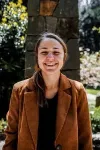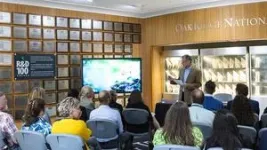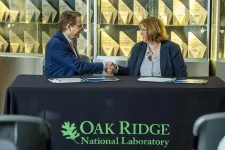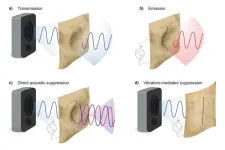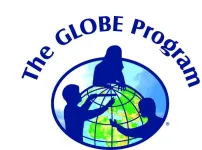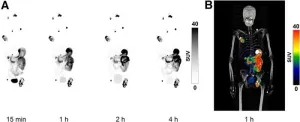(Press-News.org) URBANA, Ill. – COVID-19 vaccination rates remain low in many African countries, often because providing access to vaccines is difficult in remote areas. A new international research project showed that intervention with mobile vaccination teams in Sierra Leone is an effective way of reaching rural populations to increase vaccination uptake.
Madison Levine, a doctoral student in the Department of Agricultural and Consumer Economics (ACE), part of the College of Agricultural, Consumer and Environmental Sciences (ACES) at the University of Illinois Urbana-Champaign, participated in the project as a field research assistant. She is a co-author on the research paper, which is published in Nature, and she shared her experiences overseeing the project implementation.
“I was organizing the fieldwork, coordinating communications, and training everybody. Everything was approved by the principal investigators, of course, but I was making field plans and ensuring every route would work within the time frame we had. I assisted if there were any problems, and I was in as many villages as possible,” Levine said.
“It was challenging because we were going to very remote areas. We had a car for the project, but there were places you couldn’t go by car, so there was a lot of traveling on motorbikes, and sometimes we had to take a boat to get across an area of water. The health staff who were going with us carried the vaccines in ice boxes.”
Levine holds a master’s degree in international development economics from the University of San Francisco and she worked in Sierra Leone for several years before implementing the COVID-19 project. At Illinois, her advisors are ACE professors Hope Michelson and Sarah Janzen.
The research was conducted by a collaborative team from the International Growth Centre, University of Oxford, Yale University, and Wageningen University in cooperation with the Sierra Leone Ministry of Health and Sanitation (MoHS) and the international non-governmental organization Concern Worldwide. The Sierra Leone MoHS operates a network of peripheral health units, but many Sierra Leoneans live far away from these units, and people have to travel an average of 3.5 hours each way to reach a vaccination center.
The study included 150 rural villages in Sierra Leone that were located more than 5 miles from any health unit, and the intervention took place over several days.
“First, a team of community mobilizers would talk to the village leaders. Once the leaders approved, the team would hold a public meeting where they would talk about what the vaccine does and address any concerns. The next day, they would put up a small clinic with a couple of tables that held the medical supplies, and people would line up to get vaccinated. The MoHS assisted in providing trained nurses and medical staff for each place. All teams included local people who spoke the language of the village, which helped to build trust," Levine said.
“The majority of the communities welcomed our team. These very small villages are used to being surpassed by bigger cities, so they were happy we were coming out to them. Only two villages declined to participate, and we had to respect that.”
The study found that immunization rates increased by about 26% in the trial villages. In addition, people who were traveling nearby would also stop to get vaccinated, further increasing the uptake. On average, the cost was about $33 per person, making it a very cost-effective intervention.
While there is some misinformation and vaccine hesitancy, by far the biggest obstacle is vaccine access, Levine said. “This project clearly shows you can make it cost-effective to reach people, even in very remote areas. For instance, the COVID-19 vaccine was received for free, so there needs to be a process in place to distribute it. It has to be budgeted properly and organized well, which people are highly capable of doing. This project shows it can be done, and hopefully, it opens doors for future global health interventions.”
The paper, “Last-mile delivery increases vaccine uptake in Sierra Leone,” is published in Nature [DOI:10.1038/s41586-024-07158-w]
END
Mobile teams bring COVID-19 vaccines to rural villages in Sierra Leone
2024-05-07
ELSE PRESS RELEASES FROM THIS DATE:
Kinsey Institute study shows female gamers only label half of sexual harassment incidents they experience as such
2024-05-07
A new study from the Kinsey Institute reveals that only 50.5% of women who were targets of sexual harassment during online gaming identified qualifying incidents as such. This figure dropped further to only 42.2% for women who witnessed sexual harassment of other women while gaming.
The study included 182 women from North America who played online video games at least once a week. Researchers examined a variety of sexual harassment behaviors, from unwanted sexual remarks to explicit images to sexual threats. In line with ...
New NIH grant aims to combat sight damage from diabetes
2024-05-07
DETROIT — Fu-Shin Yu, Ph.D., professor of ophthalmology, visual and anatomical sciences in the Wayne State University School of Medicine, received an award from the National Eye Institute of the National Institutes of Health for his study aiming to reverse the adverse effects of diabetes on eyesight.
The five-year grant for $2,167,882 will benefit Yu’s research “Role of Programmed Cell Death Pathways in Bacterial Keratitis,” Which will investigate biological processes that ...
Research shows altered regulation of genes linked to prostate cancer among firefighters
2024-05-07
Firefighters may have an increased risk of prostate cancer due to on-the-job chemical exposures, according to new research from the University of Arizona Mel and Enid Zuckerman College of Public Health and University of Michigan in collaboration with fire service partners and researchers around the country through the Fire Fighter Cancer Cohort Study.
Prostate cancer is the leading incident cancer among U.S. males. Firefighters are diagnosed with prostate cancer at a rate 1.21 times higher than the general population, possibly because of chemical exposures including smoke and firefighting foam during firefighting.
Some of those chemicals ...
Seven ORNL inventions licensed to Texas-based lithium recovery firm
2024-05-07
A collection of seven technologies for lithium recovery developed by scientists from the Department of Energy’s Oak Ridge National Laboratory has been licensed to Element3, a Texas-based company focused on extracting lithium from wastewater produced by oil and gas production.
The technologies were developed through the Critical Materials Innovation Hub, a DOE Energy Innovation Hub led by Ames National Laboratory that is dedicated to accelerating scientific and technological solutions to ensure secure domestic supply chains for ...
New physicians’ exam scores tied to patient survival
2024-05-07
At a glance:
How well a newly minted doctor scores on their medical board exam appears linked to patients’ odds of dying or being readmitted to the hospital.
Doctors’ performance on ratings of knowledge and skill taken periodically during residency training is not linked to patient outcomes.
Findings offer reassurance that certification exams, which aim to demonstrate the competence of physicians, capture critical knowledge and clinical judgment skills for physicians.
How do we know whether newly minted doctors have what it takes to ...
Association of inflammatory and metabolic biomarkers and accelerated aging in cardiac catheterization patients
2024-05-07
“[...] this study is an initial examination of the associations between epigenetic and transcriptomic aging biomarkers and novel NMR lipoprotein biomarkers.”
BUFFALO, NY- May 7, 2024 – A new research paper was published in Aging (listed by MEDLINE/PubMed as "Aging (Albany NY)" and "Aging-US" by Web of Science) Volume 16, Issue 8, entitled, “Associations among NMR-measured inflammatory and metabolic biomarkers and accelerated aging in cardiac catheterization patients.”
Research ...
This sound-suppressing silk can create quiet spaces
2024-05-07
We are living in a very noisy world. From the hum of traffic outside your window to the next-door neighbor’s blaring TV to sounds from a co-worker’s cubicle, unwanted noise remains a resounding problem.
To cut through the din, an interdisciplinary collaboration of researchers from MIT and elsewhere developed a sound-suppressing silk fabric that could be used to create quiet spaces.
The fabric, which is barely thicker than a human hair, contains a special fiber that vibrates when a voltage is applied to it. The researchers leveraged those vibrations to suppress ...
New CUNY-GLOBE partnership will expand and innovate NASA’s environmental science and education program infrastructure
2024-05-07
NEW YORK, May 7, 2024 — A team of researchers from the CUNY Graduate Center, the CUNY Advanced Science Research Center (CUNY ASRC), Brooklyn College, and Lehman College has been selected to receive a highly competitive cooperative agreement award aimed at expanding and innovating NASA’s Global Learning and Observations to Benefit the Environment (GLOBE) program. The five-year, $11.1-million project awarded to the CUNY Graduate Center will help advance GLOBE’s mission to create a worldwide community of students, educators, scientists, and members of the public who work together to better understand, ...
New PET agent provides exceptional same-day imaging for clear cell renal cell carcinoma patients
2024-05-07
Reston, VA—A novel investigational PET imaging agent can rapidly and accurately visualize lesions in clear cell renal cell cancer (ccRCC) patients according to new research published in the May issue of The Journal of Nuclear Medicine. The results of the study suggest that the agent 68Ga-DPI-4452 (Debio 0328) is superior to standard CT imaging in the context of ccRCC. It also allows for significantly faster imaging and, in the future, could be utilized as part of a theranostic pair.
ccRCC accounts for 70-80 percent of renal cell carcinoma ...
Psychedelic therapy and ecological medicine symposium to be held at UCLA
2024-05-07
UCLA Health is set to host a unique symposium this week to explore the evolving research in psychedelic therapies and how combining it with reconnection to natural world could help to amplify their mental health benefits.
The all-day symposium on May 10 at the UCLA campus will bring together the expertise and insights of researchers from UCLA Health’s Psychedelic Studies Initiative and the Jane and Terry Semel Institute for Neuroscience and Human Behaviors as well as filmmakers, psychiatrists, urban planners, indigenous health experts, writers and environmental leaders from throughout the world.
“Promising ...

